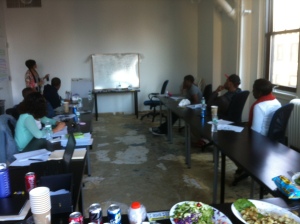Credit: Lindsay Adamski
If you want an inside look on how I develop my material and roll out new workshops, here is a case study. Last Sunday several members of NYFC YAB, accompanied by Lindsay Adamski (a.k.a., ladamski), joined me at AlleyNYC for a four-hour project management bootcamp. (Yes, you read that right: four hours on a Sunday. It was their suggestion. They are intense, these folks.) The aim was to finish the work that we started at the retreat back in August on the YAB Project Management Manual, which like their constitution, is co-authored by YAB and me. My model for this was the OCFS Handbook for Youth in Foster Care, which incorporates the voices of young people in care in every chapter. I especially liked how the handbook defines terms using the words of youth in foster care.
YAB does a terrific job of referring to a printed copy of their constitution during their meetings, and the manual is definitely supposed to act as a guide for every step of the project management process: brainstorming, project selection, planning, execution, and ending (termination, completion, and administration). Each section has handy tools and tips for success. We’re also making it available in digital format, however, because the manual is intended as a living document that they can edit over the years by modifying, clarifying, and elaborating on the existing material (e.g., working out their own ground rules and processes for each of these stages). There are exercises sprinkled throughout, so it also served as a workbook at the retreat and at the Alley bootcamp.
Full disclosure: the first project management workshop was a little rough. In a strict sense I wasn’t disappointed, though, because as with any new workshop, I was prepared for some kinks. (It’s always tough to time new activities.) Furthermore, it was the last workshop on the final day of the retreat, the youth were kind of restless and burnt out from all the work and running around we’d already done, and the creepy cabin we used as a classroom (the “dead animal room”) was not conducive to thoughtful dialogue. I’d assumed that we would finish the chapter on brainstorming rather quickly, but it took us an hour to get through the material. Nothing was too trivial for debate, and in my effort to write down everyone’s opinions, we lagged behind schedule.
It was clear that I had to recalibrate my approach (in business parlance, “pivoting” after “failure”!) for the follow-up session. This was a team effort. Lindsay got feedback from YAB about what they thought could be improved for next time, and the two of us met to discuss some tactics. Here are the ideas we all came up with: Continue reading

